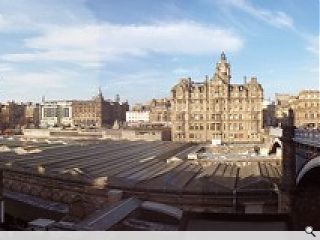Edinburgh’s Waverley Re-Development
4 Jun 2008
WAVERLEY: Why can't the city deliver a committed long term plan for its key transport hub?
Waverley is a remarkable piece of town planning. The notion of building a railway line along the bottom of Princes Street Gardens has created one of the most exciting and dramatic entrances by rail to any great city. As you arrive and emerge from the station, you move upwards, blinking in the daylight and taking in the views, right at Edinburgh’s splendid historic core. It is an extraordinary arrival sequence and one that has to be respected and enhanced. On the other hand, as city centre activities have increased and intensified, Waverley Station is now an obstacle to connections between north and south, between the New Town and the Old Town. As railway traffic grows, operational issues are becoming more intense and urgent. High speed trains have improved local and national connections, increasing passenger numbers and putting pressure on Waverley. Operationally, a key problem is that trains to the north and west of Scotland terminate in a big island block of accommodation (the ticket hall) within the station. This block is listed, so options for redevelopment are limited. It also means that through trains to the south must skirt either side of this block within a very confined space. Proposals have included raising up the listed accommodation block to let trains pass underneath and simultaneously exploiting the capacity at Haymarket by adding extra platforms and terminating more ‘‘Scotland only’’ trains there to ease the congestion of Waverley. This has been made possible with the implementation of the Edinburgh tram project which enables passengers arriving at Haymarket to feel that they are no longer on the outskirts, connecting them easily and rapidly to the rest of the city.
As a town planning and urban design set piece, Waverley figures prominently on any plans for the east end of Edinburgh. With the building of new council offices and with the proposed Mountgrange masterplan for the Caltongate, Waverley is now being encircled by city centre developments that are strengthening the connection between the Old and New Towns. But nevertheless, the station itself still seems like an enormous plug or block, and various ideas have been mooted as to how to utilise and reconnect the urban realm around it. BDP and others have produced schemes that propose building on the roof of the partially submerged station, connecting Princes Street with the Old Town. Such schemes have encountered opposition on the basis that this compromises existing views and the act of Parliament which exists to protect the historic concept of a valley that runs continuously between the Old Town and the New Town. The Design Champion initiative organised a series of events to get a convergence of opinion on what should happen in this crucial part of the city; the final event which was facilitated by Willy Roe and drew together all the senior figures in Edinburgh for an extraordinary workshop gave positive direction to a re-examination of what could be achieved. Following the workshop, Steve Smith of DEGW in collaboration with Duncan Whatmore and the Design Initiative proposed an ‘‘encircling’’ set of developments as an alternative to building on the roof.




